Subcontracting for Process Manufacturing
This chapter covers the following topics:
- Overview of Full Outsourcing for Process Manufacturing
- Subcontracting Setup for Process Manufacturing
- Subcontracting Planning for Process Manufacturing
- Subcontracting Execution for Process Manufacturing
- Full Outsourcing Accounting Process for Process Manufacturing
Overview of Full Outsourcing for Process Manufacturing
Oracle Subcontracting supports full outsourcing with external manufacturing partners in process enabled inventory organizations.
The following diagram illustrates the setup and process flow for Full Outsourcing with External MP Organizations for process manufacturing:

The key setup steps for subcontracting for process manufacturing are:
-
Enable subcontracting profile options.
-
Define Customers and Suppliers.
-
Define OEM and MP organizations and process enables inventory organizations, and associate customers and suppliers you have defined.
-
Define ingredients and products in both the MP and OEM organizations.
-
Define accounting set up.
-
Define shipping networks between the OEM and MP, and enable subcontracting relationships.
The subcontracting process for process manufacturing includes the following steps:
-
Begin by creating a purchase order (referred to as Subcontracting Order) for buying the outsourced product from the MP.
-
Create a production batch in the MP Organization against the subcontracting order automatically, using the Interlock Manager.
-
Create replenishment purchase orders in the MP Organization for procuring components from the OEM. Replenishment Purchase Orders (RPOs) are automatically created for synchronized components using the Interlock Manager. For pre-positioned components you can manually create RPOs, or use ASCP to create RPOs automatically.
-
The Interlock Manager also creates replenishment sales orders in the OEM Organization for shipping ingredients from the OEM to MP automatically.
-
Ship-confirm replenishment sales orders in the OEM Organization to ship ingredients to the MP.
-
Run the Auto Receive Components concurrent program to automatically receive the ingredients in the MP.
-
Receive the outsourced products in the OEM Organization against subcontracting orders created in Step 1.
-
Run the Process Receiving Transactions concurrent program. This step completes the production batch, backflushes the ingredients, and reduces the inventory of the outsourced product by an appropriate amount in the MP organization.
Subcontracting Setup for Process Manufacturing
The setup steps described in the chapter Setting Up Subcontracting for Discrete Manufacturing, apply to full outsourcing with external MP for Process Manufacturing, the difference being that both the OEM and the MP are set up as process enabled inventory organizations. Define the OEM and MP organizations as Process Manufacturing Organizations by adding Organization Classification as Process Manufacturing for both.
To review the set up steps for discrete manufacturing, see, Overview of Setting Up
Setting Profile Options
In the System Profile Values form, query for the profile JMF: Enable Subcontracting”, and set this profile option to Yes at site level.
See: Setting Profile Options.
Setting Up OEM Organizations
The Original Equipment Manufacturer (OEM) is the manufacturing company that owns the product designs it sells. The OEM manages its supply chain whether the manufacturing processes are internal or outsourced to Manufacturing Partner (MP). The OEM organization is the organization that buys an outsourced product, and ships subcontracting ingredients to the MP.
For Full Outsourcing with External MP in process enabled organizations, define and set up the Original Equipment Manufacturer (OEM) as process manufacturing enabled:
-
From the Inventory responsibility, navigate to the Organization window.
-
Define the OEM organization as an inventory organization. Select the Location, and Location Address of the country for which you are setting up Full Outsourcing.
-
Select Others. The Additional Organization Information window appears.
-
Select Inventory Information to view the Organization Parameters window.
-
Select the Process Manufacturing Enabled check box.
-
Select the Costing Information tab.
-
For full outsourcing, set the Costing Method of the OEM to Standard.
-
Since the OEM is a regular inventory organization, select Yes for Transfer to GL to post all accounting transactions to the general ledger.
-
Save your work.
Setting Up MP Organizations
A Manufacturing Partner (MP) is a business that performs a contract manufacturing function for the OEM. It receives intermediate products from an OEM or from other trading partners on which it perform additional work.
For Full Outsourcing with External MP in process enabled organizations, define and set up the MP as process manufacturing enabled:
-
Navigate to the Organization window.
-
Define the MP organization as an inventory organization. Select the Location and the Location Address of the country for which you are setting up full outsourcing for process manufacturing organizations.
-
Click Others. The Additional Organization Information window appears.
-
Select Inventory Information. The Organization Parameters window appears.
-
In the Organization Parameters window, check the Manufacturing Partner Organization indicator to select the Manufacturing Partner Type.
-
Select Manufacturing Partner Type as External.
-
Select the Process Manufacturing Enabled check box.
-
Select the Costing Information tab.
-
Select No for Transfer to GL if the MP organization type is external, as the MP organization is created for simulation and the accounting transactions for this organization should not be transferred to the general ledger.
-
Save your work.
For additional information about setting up an Organization, see:
-
Defining Inter-Organization Information, Oracle Inventory User's Guide
-
Organization Parameters Window, Oracle Inventory User's Guide
To enable the automatic creation of replenishment purchase orders and automatic receiving of components in the MP organization, set up the receiving options in the MP organization. See: To set up receiving options for MP organizations in Setting up Manufacturing Partner Organizations.
-
Setting Up Product Development Parameters for Process Enabled Organizations
To use the full outsourcing solution for process enabled organizations, you will need to set up parameters for new organizations, or query and modify parameters for existing organizations.
-
Navigate to the Product Development Parameters window to enter parameters for new organizations.
Navigate to the Find Product Development Parameters window to enter parameters for existing organizations.
-
To enter the required parameter information see the topic Setting Up Parameters, Oracle Process Manufacturing Product Development User's Guide.
Setting Up Formulas, Recipes, and Routings
To use the full outsourcing solution for process enabled organizations, you will need to create and set up:
-
Formulas in the OEM or MP organization for the outsourced product and include the ingredients required to produce that outsourced product.
-
Recipes without routing in the OEM or MP organization.
-
Validity rules for the recipes that you create. Rules should be valid for the MP to create production batches in the MP organization.
To set up a formula for full outsourcing external organizations for process manufacturing
Create a formula in the OEM or MP organization for the outsourced product and include the ingredients required to produce the product.
-
Navigate to the Formula Details window.
Enter information as described in the topic Entering Formula Details, Oracle Process Manufacturing Product Development User's Guide.
-
In the Products tab of the Formula Details form, set yield type to incremental for the product.
-
In the Ingredients tab of the Formula Details form, set the consumption type to incremental for the ingredient.
To set up a recipe for full outsourcing external organizations for process manufacturing
-
Navigate to the Recipe Details window.
Enter information as described in the topic Entering Recipe Details, Oracle Process Manufacturing Product Development User's Guide.
-
Create a recipe without routing in the OEM or MP organization.
To set up a validity rule for a recipe for full outsourcing external organizations for process manufacturing
-
Navigate to the Recipe Validity Rule Details window.
Enter information as described in the topic Editing Recipe Validity Rules, Oracle Process Manufacturing Product Development User's Guide.
-
Create a global or organization specific validity rule for the recipe you have created.
-
Setting Up Process Execution Parameters
Ensure that you validate that the supply subinventory, and yield subinventory are defined if the organization is Manufacturing Partner enabled.
-
Navigate to the Process Execution Parameters window.
See: Setting Up Parameters, Oracle Process Manufacturing Process Execution User's Guide.
-
In the Process Execution Parameters window, search for the MP organization
-
In the Inventory Transactions tab, enter the values for the Supply Subinventory and Yield Subinventory field values. If the subcontracting product and ingredient items are locator controlled, enter Supply Locator and Yield Locator values.
Defining Customers and Suppliers
Full outsourcing with external MPs in process enabled inventory organizations follows the same setup steps for defining customers and suppliers. The MP acts as both supplier and customer, and the OEM acts as a supplier. Define the OEM as a supplier and supplier site, and the MP as a customer and customer site as well as a supplier and supplier site. You will then associate these roles in the OEM and MP organizations, respectively. See: Defining Customers and Suppliers.
Associating Customers and Suppliers
Full outsourcing with external MPs in process enabled inventory organizations follows the same setup steps for associating customers and suppliers. For the OEM organization, associate the supplier and supplier site. For the MP organization, associate the customer and customer site, as well as the supplier and supplier site. See: Associating Customers and Suppliers Associating Customers and Suppliers.
Setting Up Order Management Transaction Types
Set up the following in Oracle Order Management:
-
Define new transaction type for AR.
-
Define new transaction source.
-
Define price list.
-
Define document sequence for new created order management type.
-
Assign Document sequence to new created order management type.
See the Oracle Order Management User's Guide for detailed information.
Full outsourcing with external MPs in process enabled inventory organizations follows the same setup steps to set up a separate order type for creating replenishment sales orders for component shipments to the MP. See: Setting Up Specific Order Management Transaction Types for Subcontracting.
Setting up Shipping Networks
Use the Subcontracting tab in the Shipping Network window and select the:
-
Subcontracting Type as Full.
-
Default Order Type as OM truncation type defined.
Ensure you update the relevant accounts in the Shipping Networks window.
Full outsourcing with external MPs in process enabled inventory organizations follows the same setup steps to define inventory shipping networks between the OEM and the MP. See: Setting Up a Shipping Network.
Setting Up Standard Costs of Ingredients and Products
Set up the standard costs of subcontracting ingredients and outsourced product in the OEM organization. The MP organization is a simulation organization, and accounting transactions are not transferred to GL. Therefore, no costing setup is required in the MP organization.
To setup standard cost of subcontracting ingredients in the OEM organization
Subcontracting ingredients can be purchase items or product items. The cost is set up like any standard ingredient.
To setup standard cost of outsourced products in the OEM organization
Standard cost of the outsourced product must include material cost and the added value. While setting up the cost, include ingredient cost as material cost and added value as OSP (define an OSP resourced in the OEM organization and define an OSP charge as added value) charges and run cost update.
-
Navigate to the Item Costs window.
-
Enter information as given in the topic Defining Standard Item Costs in the Oracle Process Manufacturing Cost Management User's Guide.
Setting Up Subcontracting Accounting
To set up accounting for full outsourcing for process enabled inventory organizations, perform the following setup in Oracle Sublegder Accounting (SLA):
-
Assign source, Outsource Manufacturing Flag to the event class Shipments and Deliver to or Return from Inventory.
-
Create new account derivation rules populating the subcontracting in transit account for the journal line type, DCOGS, COGS and PPV.
-
Assign the new account derivation rules defined for DCOGS to the journal line definition, Sales Order Issue of event class Shipments.
-
Assign the new account derivation rules defined for COGS to the journal line definition, COGS Recognition of event class Shipments.
-
Assign the new account derivation rules defined for PPV to the journal line definition, PO Receipt of event class Deliver to or Return from Inventory.
-
Assign the journal line definition to Application Accounting Definition.
-
Assign Application Accounting Definition to Subledger Accounting Method.
See the following topics in Oracle Subledger Accounting Implementation Guide:
-
Subledger Accounting Options Setup Overview
-
Journal Lines Definitions
-
Account Derivation Rules
-
Application Accounting Definitions
-
Subledger Accounting Methods
-
Subcontracting Planning for Process Manufacturing
For the full outsourcing with external organization subcontracting solution for process manufacturing, Advanced Supply Chain Planning (ASCP) plans the ingredient requirements in both OEM and MP organizations, and uses organization definitions and customer-supplier associations you have defined as a part of the subcontracting setup steps. ASCP nets the demand and supply and creates planned orders for the ingredients and products in both the OEM and MP organizations. The setup for ASCP is the same as those of the standard planning setup for items. No special setups are required for subcontracting. See the Overview of Subcontracting Planning for Discrete Manufacturing for a summary of how to set up and run ASCP.
The following topics describe the subcontracting planning process in process enabled inventory organizations if the ingredients are synchronized, prepositioned or both:
Outsourced Product with Synchronized Ingredients
In this scenario, the outsourced product is A and its ingredients, B and C, are synchronized ingredients.
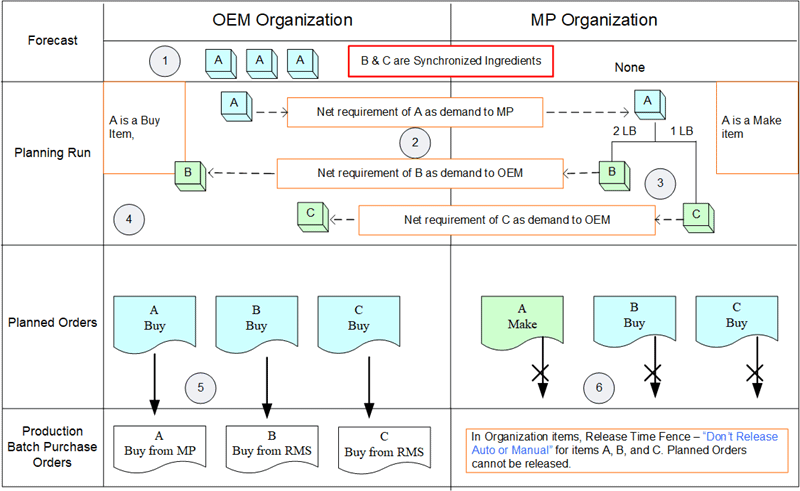
The Planning process starts when:
-
The forecast is defined for an outsourced product in the OEM organization, if the outsourced product A is an independent demand item. If A is a dependent demand item, the demand comes from its parent product.
-
The planning run considers the forecast or dependent demand of A, calculates the net requirements of A in the OEM organization, and creates a buy planned order for product A in the OEM organization. A is a buy item and is sourced from the MP organization, based on the sourcing rule and organization supplier-customer associations. The planned order demand of A in the OEM organization is transferred to the MP organization as demand of A.
-
In the MP organization, A is a make item, demand is netted, and a make planned order is created for Product A. Ingredients B and C requirements are calculated, netted, and buy planned orders are created. Since these ingredients are sourced from the OEM organization (based on the sourcing rules, supplier, and site associations of the OEM organization), the buy planned order demand for ingredients B and C is transferred to the OEM organization.
-
In the OEM organization, ingredients B and C requirements are netted because these ingredients are sourced from the RMS (based on sourcing rules). Buy planned orders are created for these ingredients in the OEM organization.
-
In the OEM organization, buy planned orders can be transferred from Planning to Purchasing as purchase requisitions. (The release time fence is set to Null for outsourced product A, and ingredients B and C in Organization Items.) Purchase orders and blanket releases are created from these purchase requisitions. Purchase orders and blanket releases created for outsourced products are referred to as subcontracting orders.
-
In the MP organization, make and buy planned orders of the outsourced product A and ingredients B and C cannot be transferred as production batches or purchase requisitions because the release time fence is set to Don't Release Auto or Manual for all of them in the MP organization. For these planned orders, the Attribute Action is set to None, which prevents releasing these planned orders.
Note: You can view planned work orders using the Planner Workbench.
The Interlock Manager concurrent request creates production batches for product A and purchase orders for ingredients B and C during the simulation run (for details see: Subcontracting Execution for Process Manufacturing). These production jobs and purchase orders represent supply and are considered in subsequent planning runs.
For more information on subcontracting concurrent programs, see Overview of Subcontracting Concurrent Programs.
Outsourced Product with Prepositioned Ingredients
In this scenario, the outsourced product is A and its ingredients, B and C, are prepositioned ingredients:
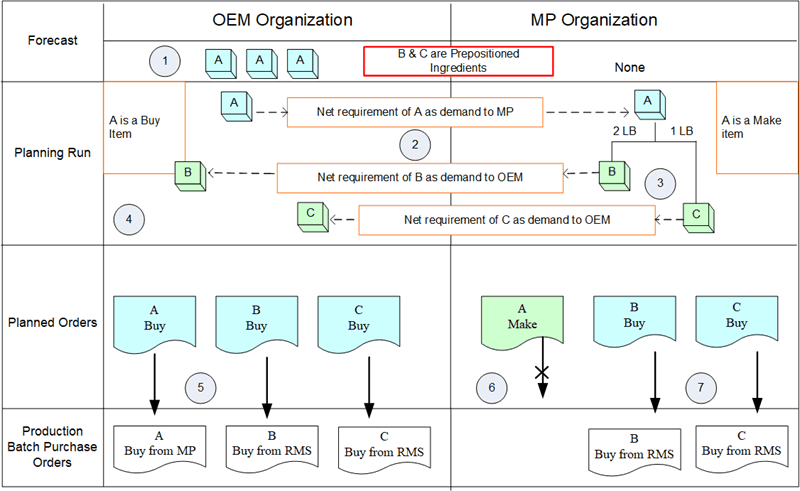
The planning process is the same as that of the outsourced product with synchronized ingredients. The only exception is that planned orders of prepositioned ingredients B and C can be transferred to Purchasing as purchase requisitions:
-
The forecast is defined for the outsourced product in the OEM organization, if the outsourced product A is an independent demand item. If A is a dependent demand item, demand comes from its parent product.
-
The planning run considers forecast or dependent demand of A, calculates the net requirements of A in the OEM organization, and creates a buy planned order for product A in the OEM organization. Since Product A is a buy item and is sourced from the MP organization, the planned order demand of A in the OEM organization is transferred to the MP organization as demand of A.
-
In the MP organization, A is a make item based on the organization, demand is net calculation, and a make planned order is created for Product A. The requirements for ingredients B and C are calculated, the net calculated, and buy planned orders are created. Since these components are sourced from the OEM organization, and the buy planned order demand of ingredients B and C is transferred to the OEM organization.
-
In the OEM organization, requirements for ingredients B and C are netted because these ingredients are sourced from the RMS (based on sourcing rules). Buy planned orders are created for these ingredients in the OEM organization.
-
In the OEM organization, buy planned orders can be transferred from Planning to Purchasing as purchase requisitions. (The release time fence is set to Null for outsourced product A, and ingredients B and C in Organization Items). Purchase orders and blanket releases are created from these purchase requisitions. Purchase orders and blanket releases created for the outsourced products are referred to as subcontracting orders.
-
In the MP organization, make planned orders of outsourced product A can be transferred as WIP jobs as the release time fence is set to Don't Release Auto or Manual for the outsourced product in MP organization. The make planned order Attribute Action is set to None (it can be viewed on the planning workbench), which prevents the release of these planned orders.
-
Buy Planned orders of ingredients B and C can be transferred to Purchasing as requisitions as the release time fence is set to Null for both the ingredients in the MP organization.
The Interlock Manager concurrent request creates production batches for product A during the interlock run. These production batches represent supply, and are considered in subsequent planning runs.
For more information on subcontracting concurrent programs, see Overview of Subcontracting Concurrent Programs.
Outsourced Product with Prepositioned and Synchronized Ingredients
In this scenario, the outsourced product is A and its ingredients, B and C are prepositioned and synchronized ingredients respectively:
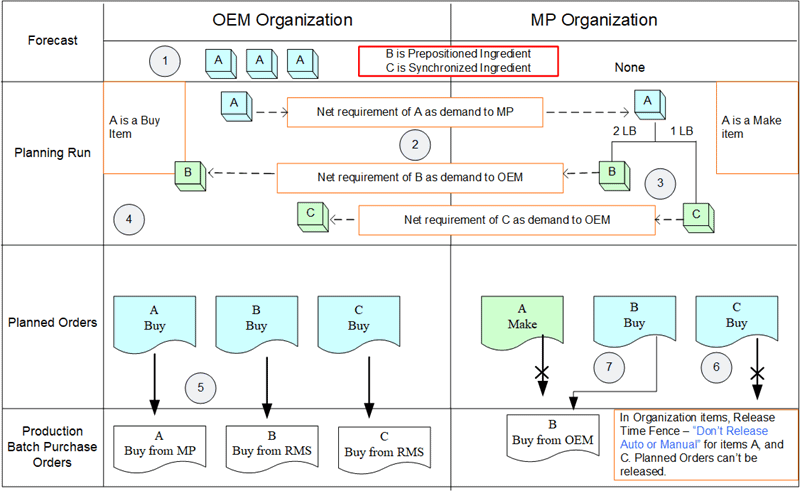
The planning process is a combination of the given processes involving synchronized ingredients and prepositioned ingredients:
-
The forecast is defined for the outsourced product in the OEM organization, if the outsourced product A is an independent demand item. If A is a dependent demand item, then demand comes from its parent product.
-
The planning run considers forecast or dependent demand of A, calculates the net the requirements of A in the OEM organization, and creates a buy planned order for product A in the OEM organization. A is a buy item that is sourced from the MP organization, so the planned order demand of A in the OEM organization is transferred to the MP organization as demand of A.
-
In the MP organization, A is a make item, demand is netted, and a make planned order is created for Product A. Ingredients B and C requirements are calculated, netted, and buy planned orders are created. Since these ingredients are sourced from the OEM organization, the buy planned order demand of ingredients B and C is transferred to the OEM organization.
-
In the OEM organization, ingredients B and C requirements are netted, and sourced from the RMS (based on sourcing rules). The buy planned orders are created for these ingredients in the OEM organization.
-
In the OEM organization, buy planned orders can be transferred from Planning to Purchasing as purchase requisitions. Purchase orders and blanket releases are created from these purchase requisitions. Purchase orders and blanket releases created for the outsourced product are referred to as subcontracting orders.
-
In the MP organization, make planned orders of outsourced product A and buy planned orders of Component C cannot be transferred as production batches because purchase requisitions as the Release Time Fence is set to Don't Release Auto or Manual in the MP organization. The Planned Order Attribute Action is set to None which prevents releasing these planned orders. You can use the Planner Workbench to view the planned orders.
-
Buy planned orders of ingredient B can be transferred to Purchasing as requisitions as the Release Time Fence is set to Null for both the components in MP organization.
The Interlock Manager concurrent request creates production batches for product A and replenishment purchase orders for ingredient B during the interlock run. These production batches and replenishment purchase orders represent supply, and are considered in the subsequent planning runs.
For more information on subcontracting concurrent programs, see Overview of Subcontracting Concurrent Programs.
Subcontracting Execution for Process Manufacturing
The Subcontracting execution process for process enabled inventory organizations begins with the subcontracting orders for the outsourced products and the replenishment purchase orders for the ingredients. The following sections detail the process steps for each scenario.
Outsourced Products with Synchronized Ingredients
In this scenario, the execution starts with the subcontracting orders being transferred from ASCP. You can also create subcontracting orders manually.
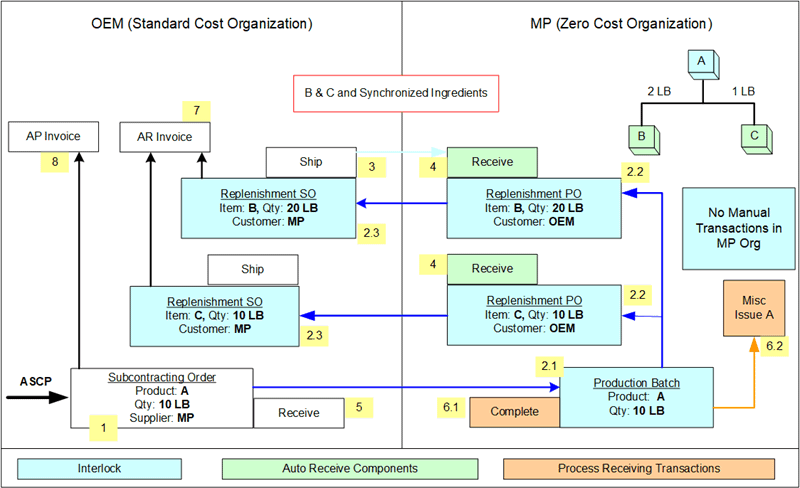
-
The execution process starts with the subcontracting order of Product A. These subcontracting orders are the standard purchase orders and blanket releases.
-
The Interlock Manager picks up the subcontracting orders which were not processed in the previous run of the subcontracting orders and performs the following:
-
2.1. The Interlock Manager creates a production batch for the subcontracted order quantity for simulating the manufacturing in the MP organization.
-
2.2. The OEM supplies ingredients B and C which are required to manufacture this product. Since B and C are synchronized ingredients, (meaning that these ingredients need to be shipped along with the order), the Interlock Manager creates a replenishment purchase order for the ingredients with the supplier associated with the OEM organization. The replenishment purchase order created in the MP organization denotes the supply and is considered by ASCP as supply.
-
2.3. The Interlock Manager also creates a replenishment sales order for shipping the ingredients in the OEM for the corresponding replenishment purchase order in the MP organization. Replenishment sales orders created in the OEM will always have a reference to its corresponding purchase order in the MP organization. The order type is retrieved from shipping networks (From Org: OEM and To Org: MP). The subcontracting default order type and the prices of the components are picked from price lists associated with the customer site in the sales order (defined in the price lists setup). Sales orders are always created with a booked status and are ready for shipment. These replenishment sales orders are allocated to the respective subcontracting orders to meet the ingredient requirements for manufacturing the product at the MP's site. (The Allocations Table in the Subcontracting Data Model holds this information for tracking.)
-
-
Replenishment sales orders created for the subcontracting ingredients are used for shipping the ingredients like any other standard sales orders.
-
The Auto Receive Components concurrent request picks up these shipments in the OEM organization, and creates receipts in the MP organization against the corresponding purchase order. Sales orders with shipped date and the in-transit lead time (defined in the shipping networks default shipping method) that is less than or equal to the current date, are automatically received to simulate the receipts in the MP organization.
-
The MP manufactures the product and ships the manufactured products to the OEM, and the OEM receives these receipts like other purchase order receipts.
-
The Process Receiving Transactions concurrent request picks up these receipts in the OEM organization and performs the following:
-
6.1. Completes the production batch for the product. When the production batch is completed, ingredients are backflushed, and the inventory is reduced in the MP organization. However, the completed product in the MP remains in inventory.
-
6.2. Reduces the inventory of products (completed through production batches) in the MP organization by performing by miscellaneous issues, to maintain the accuracy of the inventory records. This is because, the subcontracting order of the product is normally received in the OEM after the MP manufactures the product and sends it to the OEM. The Offset account defined in shipping networks is used for creating miscellaneous issues.
-
-
AR invoices are created for those ingredients shipped to the MP.
-
AP invoices are created for subcontracting orders received from the MP.
For more information on subcontracting concurrent programs, see Overview of Subcontracting Concurrent Programs.
Outsourced Product with Prepositioned Ingredients
In this scenario, process execution begins with the subcontracting orders for the outsourced product and the replenishment purchase orders for the prepositioned ingredients transferred from ASCP. You can also create subcontracting orders for outsourced products and replenishment purchase orders for prepositioned ingredients manually.
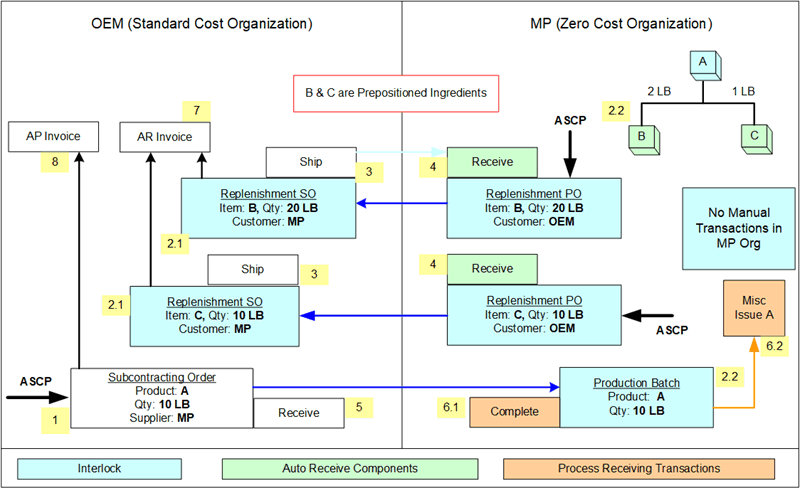
-
The execution process begins with the subcontracting order of the Product A and replenishment purchase orders of the prepositioned ingredients. Subcontracting orders are the standard purchase orders and blanket releases, and if the shipments for the outsourced product are set to Yes, then the purchase order is created for the outsourced product. Replenishment purchase orders are the standard purchase orders or blanket releases created to simulate how MP procures ingredients from the OEM.
-
The Interlock Manager concurrent request selects:
-
2.1. Replenishment purchase orders of the ingredients in the MP, and creates corresponding replenishment sales orders in the OEM for shipment of ingredients to the MP. Replenishment sales orders that are created in the OEM always reference their associated purchase orders in the MP organization. The order type is retrieved from default order type of the shipping network (From Org: OEM and To Org: MP), and the ingredients price is retrieved from the price lists associated with the customer site in the sales order. Sales orders are always created with booked status and are ready for shipment.
-
2.2. Interlock Manager then picks up the subcontracting orders that were not processed in the previous run of the subcontracting orders and creates a production batch for the subcontracted order quantity for simulating the manufacturing in the MP organization. For manufacturing this product, ingredients B and C are required in the MP organization, and the OEM must supply those materials to the MP. Since B and C are prepositioned components (meaning that components would have been shipped ahead of requirements), the Interlock Manager does not create replenishment purchase orders or sales orders for these ingredients. Instead, it looks for previously created and unallocated sales orders, and then makes allocations to these requirements. If unallocated replenishment sales orders are insufficient for the subcontracting order requirements, then Interlock Manager allocates the available quantity and leaves the remaining quantity unallocated. This situation should not happen if replenishments are available. If replenishments are available, then Interlock Manager attempts to allocate them in subsequent interlock runs.
-
-
Replenishment sales orders created for the subcontracting ingredients are used for shipping the ingredients like any other standard sales orders.
-
The Auto Receive Components concurrent request picks up these shipments in the OEM organization and creates receipts against the associated purchase orders in the MP organization. Sales orders with shipped date and in-transit lead time (defined in the shipping networks default shipping method) that is less than or equal to the current date will be automatically received to simulate the receipts in the MP organization.
-
The MP manufactures the product and ships the manufactured products to the OEM. The OEM receives these receipts the same as other purchase order receipts.
-
The Receiving Transactions concurrent request picks up these receipts in the OEM organization and:
-
6.1. Completes the production batch for the product. When the production batch is completed, ingredients are backflushed, and the inventory is reduced in the MP organization. However, the completed product in the MP remains in inventory.
-
6.2. Reduces the inventory of products (completed through production batch) in the MP organization by performing miscellaneous issues, for maintaining the accuracy of the inventory records. This is because, the subcontracting order of the product is normally received in the OEM after the MP manufactures the product and sends it to the OEM. The Offset account defined in shipping networks is used for creating miscellaneous issues. The Offset account defined in shipping networks is used for creating miscellaneous issues.
-
-
Account Receivables invoices are created for the components shipped to the MP.
-
Accounts Payables invoices are created for the subcontracting orders received from the MP.
For more information on subcontracting concurrent programs, see Overview of Subcontracting Concurrent Programs.
Outsourced Product with Prepositioned and Synchronized Ingredients
In this scenario, execution begins with the subcontracting orders of the outsourced product and replenishment purchase orders of the prepositioned ingredient being transferred from ASCP. Also, you can manually create subcontracting orders for the outsourced product and replenishment purchase orders for the prepositioned ingredients.
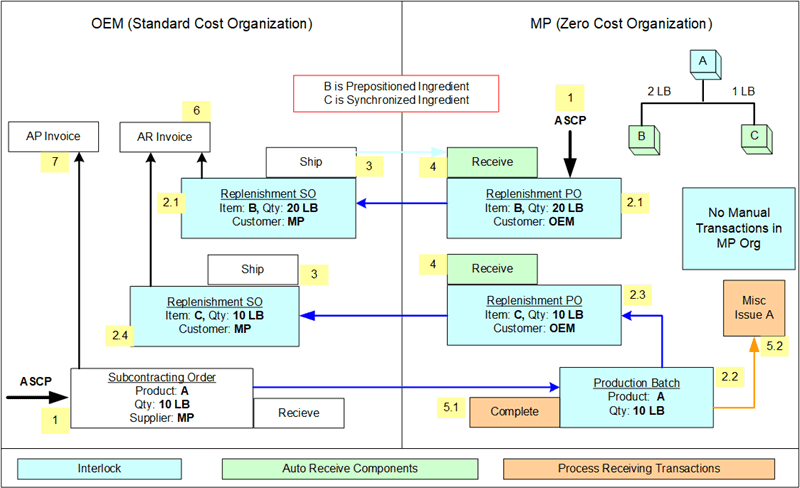
-
The execution process begins with the subcontracting order for Product A and the replenishment purchase order for prepositioned ingredient B.
-
The Interlock Manager concurrent request:
-
2.1. Picks up the replenishment purchase for ingredient B in MP and creates associated replenishment sales orders in OEM for shipment to MP.
-
2.2. Picks up the subcontracting orders that were not processed in the previous run, and creates a production batch for the subcontracting order quantity. To manufacture this product, MP needs ingredients B and C, which the OEM will supply to the MP.
As ingredient B is a prepositioned ingredient, Interlock Manager looks for available replenishment sales orders and attempts to allocate them to satisfy the subcontracting order requirement.
-
2.3. As ingredient C is a synchronized ingredient, Interlock Manager creates replenishment purchase order for this ingredient.
-
2.4. Interlock Manager creates a replenishment sales order for ingredient C with its associated replenishment purchase order in MP, and then allocates the sales order to the subcontracting order requirements.
Note: Replenishment sales orders are created for shipping the ingredients like other sales orders.
-
-
The Auto Receive Components concurrent request picks up these shipments in OEM and creates receipts in the MP using the associated purchase order. Sales orders whose shipped date and In transit Lead time (defined in the shipping networks default shipping method) are less than or equal to the current date will be automatically received to simulate the receipts in MP organization.
-
The MP manufactures the product and ships the manufactured product to the OEM. The OEM receives these receipts like other purchase order receipts.
-
The Process Receiving Transactions concurrent request picks up these receipts in OEM and:
-
5.1. Completes the production batch for the product. When the WIP job is completed, ingredients are backflushed, and the inventory is reduced in the MP organization. However, the completed product in the MP remains in inventory.
-
5.2. Reduces the inventory of products (completed through production batches) in the MP organization by performing miscellaneous issues, for maintaining the accuracy of the inventory records. This is because, the subcontracting order of the product is normally received in the OEM after the MP manufactures the product and sends it to the OEM. The Offset account defined in shipping networks is used for creating miscellaneous issues. The Offset account defined in shipping networks is used for creating miscellaneous issues.
The completed inventory of the product in MP is reduced by miscellaneous issues which causes the inventory figures in the MP organization to be accurate. The Offset account defined in shipping networks is used to create miscellaneous issues.
-
-
Accounts Receivables invoices are created for ingredients shipped to MP.
-
Accounts Payables invoices are created for subcontracting orders received from MP.
For more information on subcontracting concurrent programs, see Overview of Subcontracting Concurrent Programs.
Full Outsourcing Accounting Process for Process Manufacturing
For Full Outsourcing with external manufacturing partners in process enabled organization, the cost of the outsourced product and the subcontracting ingredients are defined by standard costing only.
Costs and Prices
For Full Outsourcing accounting for external MP organizations, the value addition should be defined as OSP charges in the costing setup and the product purchase order price should be the same as the value addition.
For details on setting up costs and prices, see Setting Up Subcontracting.
This figure illustrates the method for setting costs and prices. All amounts are in USD:
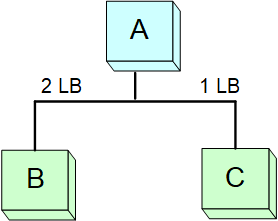
| Item | Material Cost | OSP (Added Value by MP) | Unit Cost |
|---|---|---|---|
| B | $2 | - | $2 |
| C | $3 | - | $3 |
| A | $2*2 + 3*1 = $7 | $5 | $12 |
| Item | Item Cost | Sales Price | Purchase Price |
|---|---|---|---|
| B | $2 | N/A | N/A |
| C | $3 | N/A | N/A |
| A | $12 | N/A | $12 |
To set up item prices, the Original Equipment Manufacturer (OEM) should:
-
Define material costs for the ingredients.
-
Define material and OSP charges for the product and update standard costs in the OEM organization.
OSP charges are the added-value amounts added by the MP organization. The costing in the MP organization is of no significance.
Replenishment Sales Order Shipments
This topic describes the accounting entry templates used for the replenishment sales order shipment transactions and subcontracting order receipt transactions. The journal line entries are generated upon running the OPM Accounting Pre-processor and Create Accounting programs.
Accounting transactions associated with the shipping of ingredients to MP are tracked in Intransit Account
At Ship Confirm Replenishment Sales Orders
| Account | Debit | Credit |
|---|---|---|
| For Ingredient B (2 LB) | ||
| COGS (item cost 2 USD) | 4 | - |
| Inventory Valuation (item cost 2 USD) | - | 4 |
| For Ingredient C (1 LB) | ||
| COGS (item cost 3 USD) | 3 | - |
| Inventory Valuation (item cost 2 USD) | - | 3 |
These are regular transactions. Although the inventory appears as a debit to the COGS accounts, COGS is an intransit account, reflecting the value of the material at MP site, but still owned by OEM. At the period end, use Endeca Information Discovery to view the onhand at MP site. In this example, the Intransit Value of ingredients is 7USD.
Invoicing Replenishment Sales Orders
Since the OM transaction type is Ship only, there will not be any AR transactions generated.
Subcontracting Orders Receipts
Subcontracting orders are the standard purchase orders or releases created to procure the outsourced products from the MP. Purchase orders include these events:
-
Receiving the product into the receiving location
-
Delivering the product to Inventory
All amounts are shown is USD.
Receiving for Product A
| Account | Debit | Credit |
|---|---|---|
| For Product A (1 LB) | ||
| Inventory Receiving (PO Price 5 USD) | 5 | - |
| AP Accrual (PO Price 5 USD) | - | 5 |
These entries are similar to standard items.
Delivery for Product A
| Account | Debit | Credit |
|---|---|---|
| For Product A (1 LB) | ||
| Inventory Valuation (Item Cost 12 USD) | 12 | - |
| Subcontracting Variance (PO Price - Item Cost) | - | 7 |
| Inventory Receiving (PO Price 5 USD) | - | 5 |
Inventory is debited at 12 USD, which includes the ingredient costs and added value. The Purchase Price Variance is posted to Subcontracting Variance, which is the Subcontracting Intransit account, reflecting the consumption of onhand inventory at MP site. At this moment the net debit value in the Intransit account is zero, showing the value of inventory at MP site as zero as they are consumed in the manufacturing of the product and OEM receives the product.